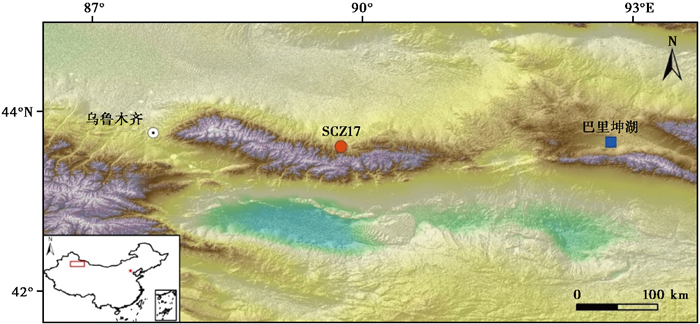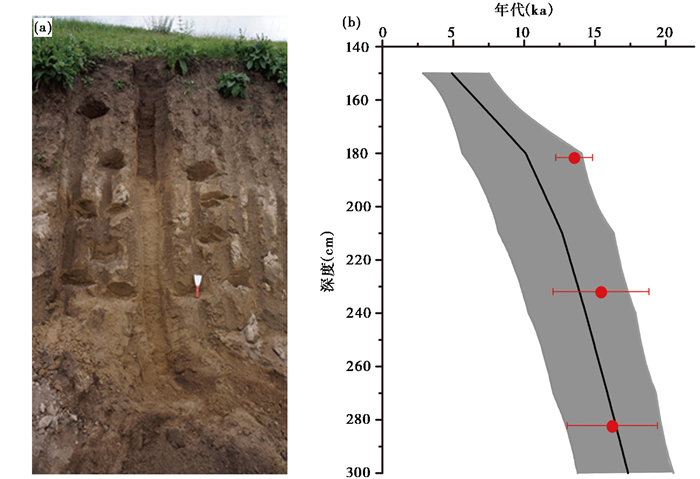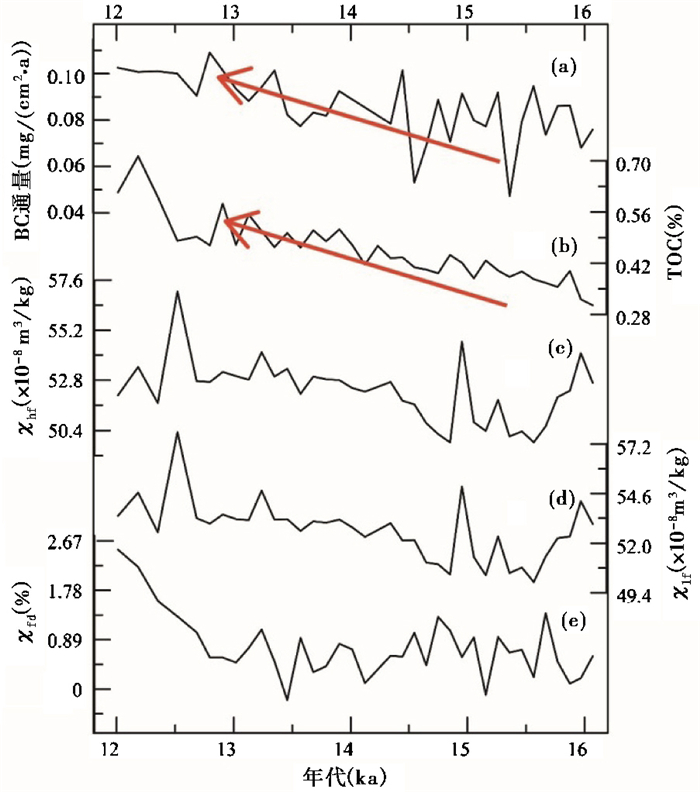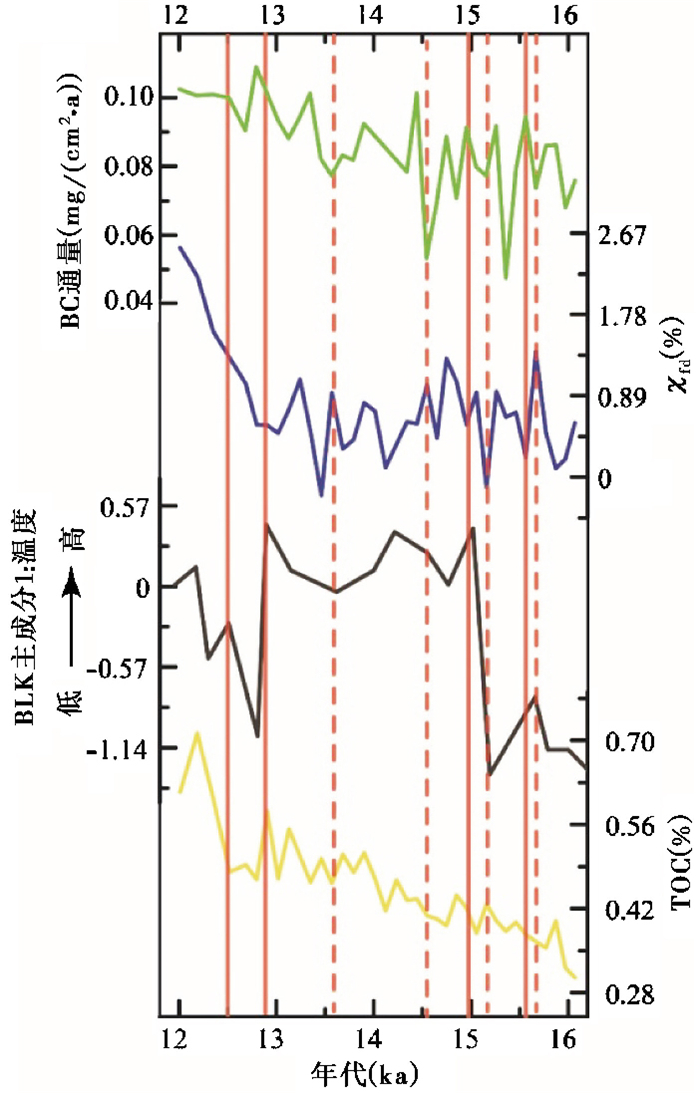2 中国气象局兰州干旱气象研究所, 甘肃省干旱气候变化与减灾重点实验室, 中国气象局干旱气候变化与减灾重点开放实验室, 甘肃 兰州 730020;
3 中国科学院 西北生态环境资源研究院, 沙漠与沙漠化重点实验室, 甘肃 兰州 730000)
近年来全球许多地区大规模且难以控制的火灾发生率的上升给人类社会造成了巨大的经济损失。火灾的发生主要受控于以下两个方面:1)人类的影响,人类行为的直接干预如点火、灭火[1~6];2)自然因素,例如气温/降水的突然变化或植被丰度/类型的改变[7~11]。目前对古火灾的研究多集中于二者的共同作用,而对自然因素尤其是气候因素与火灾相互关系的研究较少。在未来,随着人们消防安全意识的不断提高及防火措施的不断完善,气候变化很可能成为主导火灾发生的关键[12~13],所以为了更好地应对未来不断增加的极端气候(高温、干旱)可能引发的火灾,急需对过去气候-火灾相互关系进行研究以探寻火灾发生的气候背景及相关规律。但在全新世时段,人类活动显著增强,相比较而言,末次冰消期因其受人类活动影响小且气候波动较为频繁,是研究自然因素与火灾演化相互关系的理想时段之一[14~17],且已有学者研究发现快速气候变化期间通常伴随着火灾活动的显著增加(例如北美、中国黄土高原)[16]。据统计,1996~2012年全球范围内大约有15 %的火灾为草原火灾,且中亚干旱区是草原火灾主要发生地之一[18],然而目前对古火灾的研究却主要集中在北美、南美、澳大利亚、欧洲以及东亚地区[4, 7~8, 19],极少有对亚洲内陆干旱区的火灾历史的讨论。新疆位于中亚干旱区核心区,其草原面积约占总面积的30.8 % [20],该区域火灾多发且生态环境相对脆弱,对气候变化的响应敏感[21],因此亟须研究草原火灾与气候变化的相互关系。
黑碳(Black Carbon,简称BC)是生物质和化石燃料不完全燃烧产生的难熔碳质颗粒物,代表了从部分焦化物质到石墨和煤烟颗粒的连续统一体[22]。已有研究表明不同类型的火灾燃烧会释放不同量的黑碳,且黑碳更多的存在于草原火灾的灰烬残留物中[23]。此外,由于黑碳在自然条件下具有相对惰性和抗氧化、生物降解的作用,可以在沉积物中长时间保存,故沉积物中的黑碳可作为自然火灾的可靠证据[24~26],现被广泛用于区域火灾历史的重建[27]。
本文通过新疆石城子黄土剖面的黑碳记录,重建末次冰消期该区的火灾历史,并结合总有机碳(TOC)、磁化率等数据来共同探讨火灾演变与气候变化的相互关系。
1 研究区域及采样新疆的黄土广泛分布于昆仑山北坡、天山南北坡和伊犁河谷地区[28]。本研究选取的SCZ17剖面(43°37′2.34″N,89°45′31.67″E;1752 m a.s.l.)位于东天山之博格达山北坡的江布拉克景区(图 1),博格达峰是天山东部的最高峰和最大的冰川中心[29],冬季寒冷干燥,夏季温暖,是典型的中纬大陆型气候[21],气温年较差和日较差大,降水量少而变率大,且集中分布在夏季[30],夏季降水占全年的77 %左右。景区平均海拔约2200 m,年降水量350~500 mm,年均温度0~3 ℃。区域植被垂直地带性明显,从山麓到山顶依次分布着山麓绿洲-荒漠带、森林草原带、高山草甸带和高山冰雪带[31~32]。如图 2a所示,SCZ17剖面深390 cm,该剖面黄土-古土壤序列发生层和层位完整连续,而且层位稳定,界限清晰,易于识别和划分。根据剖面结构和质地特征,对SCZ17剖面地层划分如下[33]:

|
图 1 研究区和采样点位置以及本文涉及的研究点 SCZ17剖面(红色圆圈);后文讨论中提及的巴里坤湖(蓝色方框) Fig. 1 Map of study area and location of sampling and other records in the text:SCZ17 profile(red circle); Lake Balikun mentioned in the discussion later(blue square) |

|
图 2 SCZ17剖面图片(a)和研究时段年代-深度模型(b) Fig. 2 The picture (a) and the age-depth model (b) of SCZ17 profile |
(1) 390~180 cm,主要为粉砂质黄土,块状结构,富含蜗牛,可见根孔;
(2) 180~140 cm浅黑色土壤,颗粒比下层的黄土细,略呈团粒结构,根孔很多;
(3) 140~30 cm,为全新世古土壤层,多根系孔洞,团粒结构明显;
(4) 30~0 cm,为现代表土层,团粒结构,多根系孔洞,可见现代蜗牛。
对该剖面自上而下以2 cm间隔连续采样,共195个样品。
2 年代学结果光释光测年现已被广泛地用于黄土研究中,并取得了重大成果[34~39]。近年来,石英光释光测年方法也常被学者们用于新疆末次冰期黄土沉积年代的测定[40~44],而且石英单片再生剂量法(SAR)也成功用于测定天山北麓黄土沉积的年代[41, 45~46],本文即采用石英单片再生剂量法进行剖面年代测定。因此,野外考察中利用直径5 cm,长33 cm的不锈钢钢管采集了光释光(OSL)样品,样品的前处理和年代测试均在兰州大学西部环境教育部重点实验室完成。基于粗颗粒石英光释光的测年结果,利用Bacon软件建立了本剖面的年代序列[47~48],结果表明SCZ17黄土剖面主要记录了研究区末次冰期晚期(21 ka)以来的环境演变特征。在这项研究中,我们主要关注202~274 cm(对应年代为12.01~16.07 ka)这一段区域(年代结果见图 2b和表 1),以研究末次冰消期气候和火灾状况的记录,基于黑碳(BC)、有机质含量和磁化率分析,来对这一时间段的火灾历史及其驱动因素进行探讨。
| 表 1 SCZ17剖面石英OSL年代取样深度与测年结果* Table 1 Sampling depth and dating results of quartz-OSL age from SCZ17 profile |
在本研究中黑碳用来描述焦炭和烟炱的组合物质。已有研究表明,焦炭颗粒可用来指示区域范围内的火灾事件(大多源于20~100 ka范围)[49];而烟炱颗粒则可能悬浮大气中数月,反映区域或者全球范围内生物质燃烧状况[50]。本次测试结果中焦炭的含量约占黑碳总量的2/ 3及以上,因此我们认为在本文中黑碳主要可用来重建区域范围内的生物质燃烧历史。一般来说,黑碳沉积通量可指示火灾活动的频率大小,通量高则代表火灾活动频率高,低值则相反[51]。
磁化率是黄土研究中广泛使用的替代指标。先前的研究[52]表明磁化率仅在降水量较多、气候条件较好、原生磁性矿物含量低的情况下,才能很好的反映成壤强度;在降水量少、气候条件差、原生磁性矿物含量高的情况下,更多反映原生磁性矿物的磁学性质,不能反映成壤强度。由于次生磁性矿物主要为细粒磁性矿物,反映磁性矿物中细粒磁性矿物含量的磁学参数可以作为地层成壤强度的替代性参数(例如χfd %和χARM/SIRM),可用来恢复古气候,在一定程度上代表区域湿度变化,高值指示气候湿润,低值则相反[28, 52]。
黄土总有机碳(TOC)包含生物成壤作用形成的腐殖质中有机碳含量,已有研究表明TOC含量与植被盖度变化量呈正相关[53],总有机碳值高表示植被较茂盛,生物成壤作用较强,土层有机质积累多;总有机碳值低则表示植被相对稀少,土层有机质积累少。
同时为了更好地探讨火灾与气候变化间的相互关系,本文对黑碳沉积通量数据和频率磁化率指示的湿度数据以及巴里坤湖孢粉记录的温度数据[54]均进行Hilbert-Huang变换(HHT)集成经验模态分解(EEMD)[55~56],以去除长期趋势及短时间尺度的噪声。通过对黑碳通量和上述温度湿度数据进行EEMD分解可以得到3或者4个分量(IMFs)(Cj,j=1,2,3或4)及残差序列,这些IMFs依次反映了不同时间尺度的指标波动特征。
3.1 黑碳分离与测试黄土样品经室温干燥后,利用玛瑙研钵研磨至200目以下。用千分之一电子天平称0.4 g样品装入10 ml的聚乙烯塑料试管中准备进行化学处理。
(1) 去碳酸盐:取5 ml 0.5 mol/L的盐酸溶液缓慢滴入试管中,60 ℃下水浴反应24 h,水浴加热反应期间,每隔4~6 h借助涡旋振荡器振荡塑料管中的样品,使反应充分进行(下同)。反应后的样品用二次去离子水水洗离心3~4次(4000 r/min,15 min/次),使得上清液的pH> 5,将上清液轻轻倒掉。
(2) 去硅酸盐:取V(浓HF):V(HCl,6 mol/L) =2 ︰ 1的溶液5 ml缓慢加入试管中,于60 ℃水浴反应24 h。反应后的样品用二次去离子水水洗离心3~4次(4000 r/min,15 min/次),使得上清液的pH> 6,将上清液轻轻倒掉。
(3) 去除新生矿物:最后量取5 ml 4 mol/L HCl溶液缓慢加入试管中,60 ℃水浴反应24 h。反应后的样品再次用二次去离子水水洗离心3~4次(4000 r/min,15 min/次),使得上清液pH> 6。
(4) 过滤:过滤时使用的滤膜为英国Whatmanφ90 mm高纯石英纤维滤膜,过滤前,将滤膜置于450 ℃的马弗炉中灼烧4 h,以去除残留的碳质污染物和其他杂质。将处理得到的黑碳样品倒入250 ml烧杯中加二次去离子水稀释并充分搅拌均匀,然后用砂芯过滤装置进行过滤,之后将滤膜放入滤膜盒中于室温干燥后准备后续测定。
黑碳测定时使用Han等[57]2007年提出的黑碳测试方法(热光反射法):所有样品通过DRI Model 2001型热光分析仪(中国气象局兰州干旱气象研究所),采用IMPROVE(Interagency Monitoring of Protected Visual Environment)协议,分别对样品进行黑碳组分分析。用打孔取样器从滤膜上截取0.296 cm2的圆形滤膜用于OC、EC分析,分析过程为:在纯He通入的情况下,温度阶段性上升到120 ℃、250 ℃、450 ℃和550 ℃,生成4个有机碳组分(OC1、OC2、OC3和OC4);然后通入2 % O2/ 98 % He的混合气体,温度阶段性上升到550 ℃、700 ℃和800 ℃,生成3个元素碳组分(EC1、EC2和EC3)。上述各温度梯度下产生的气体经氧化炉(MnO2)催化氧化为CO2,于还原环境下转化为CH4,用火焰离子检测器(FID)测定含碳量。在纯He环境的加热过程中,有一部分有机碳量通过氦-氖激光光度计来定量。通常定义黑碳为EC1+EC2+EC3-POC[57~58]。
3.2 磁化率测定样品称重后用塑料薄膜包紧,装入样品盒并压实,进行系统的磁学参数测定。本次测试在兰州大学西部环境教育部重点实验室完成,采用英国Bartington仪器公司生产的MS2型磁化率仪,分别测试了37个样品的低频磁化率(470Hz)和高频磁化率(4700Hz),为保证测试精度,高、低频磁化率均重复测试3次,并求出其算数平均值,然后分别计算出低频磁化率(χlf)、高频磁化率(χhf)以及频率磁化率(χfd % =(χlf-χhf)/χlf)。
3.3 总有机碳(TOC)测定每个样品取3 g左右,置于透水坩埚当中,用玻璃滴管往装有样品的透水坩埚里面逐个滴加10 %的盐酸,重复上述加酸过程,并往玻璃托盘里面加盐酸,最终使得盐酸的液面高度约达到透水干锅的2/ 3,加酸完成之后,静置在室温下反应6 h左右,然后用洗瓶往每个坩埚中加入适量蒸馏水,直至上层清液的pH值达到中性为止;洗酸完成后的样品,等到水完全漏干,放入烘箱当中不超过80 ℃烘干,烘干的样品从坩埚中转移到玛瑙研钵,充分研磨粉碎之后,使用德国耶拿HT1300总碳分析仪对样品TOC进行测试。
4 实验结果黑碳通量用于指示生物质燃烧频率的变化,如图 3a所示SCZ17剖面的黑碳通量在0.05~0.11 mg/(cm2 ·a)之间变化,且在末次冰消期期间呈上升趋势,表明生物质燃烧频率在逐渐增加;剖面总有机碳(TOC)在0.31 % ~0.71 %范围内变化,平均值为0.45 %,呈逐渐上升的趋势(图 3b);高频磁化率在49.84×10-8~ 57.05×10-8 m3/kg范围内变化(图 3c);低频磁化率49.95×10-8~ 57.81×10-8 m3/kg范围内变化(图 3d),二者具有相同的变化趋势,但总体上低频磁化率较高频磁化率略高。频率磁化率可用来指示细粒磁铁矿的含量[59~60],剖面χfd %取值范围在(- 0.2 % ~2.5 %)(图 3e),说明磁性矿物中细粒磁铁矿含量低,表明粗粒磁铁矿是地层的主要磁性矿物。其中χfd %所含负值除了与实验中测量误差有关外,还有可能与样品中成壤作用生成的超顺磁颗粒和磁性矿物含量很少有关。

|
图 3 SCZ17剖面不同指标结果 (a)黑碳(BC)通量曲线;(b)总有机碳含量(TOC);(c)高频磁化率曲线(χhf);(d)低频磁化率曲线(χlf);(e)频率磁化率曲线(χfd %) Fig. 3 Results of multi-proxies from the SCZ17 profile: (a)Flux curve of Black Carbon(BC); (b)Curve of total organic carbon(TOC); (c)Curve of high-frequency magnetic susceptibility(χhf); (d)Curve of low-frequency magnetic susceptibility(χlf); (e)Curve of frequency-dependent magnetic susceptibility(χfd %) |
值得注意的是,如图 4,黑碳通量谷值大多对应于频率磁化率的峰值,同时我们将巴里坤湖(43°36′~43°45′N,92°42′~92°54′E;海拔1575 m)孢粉记录的温度数据[54]与黑碳结果进行对比,发现黑碳通量峰值与PCA1峰值出现时间同样具有很好的一致性。为了探究其中的原因,故又对上述指标进行了EEMD分解。结果表明:黑碳通量具有平均周期为328.7 a、940.1 a和3586.8 a这3个不同的IMF分量;巴里坤湖温度具有平均周期为746.7 a、1396 a和2900 a这3个不同的IMF分量;χfd %具有平均周期为360.7 a、575.3 a、1206.6 a和3785.4这4个尺度的IMF分量。考虑到本文旨在讨论火灾与气候变化的相互关系,故选取了周期相近且对曲线贡献较大的分量,即940.1 a、746.7 a和575.3 a。

|
图 4 SCZ17剖面BC通量、TOC以及χfd %与巴里坤湖孢粉记录的温度对比 垂直实线/虚线代表温度峰/谷值与BC通量峰/谷值重合时间;巴里坤温度数据源自文献[54] Fig. 4 Comparison of BC flux, TOC and χfd % from SCZ17 profile with the temperature recorded by pollen from Lake Balikun(BLK). The vertical solid/dashed line represents the time when the peak/valley of temperature and the peak/valley of BC flux coincide. The data of BLK temperature derived from reference[54]) |
在16~15 ka期间,磁化率、总有机碳含量以及巴里坤湖孢粉记录的温度低值表明此时区域气候冷干且植被盖度低,同时黑碳通量处于较低水平(图 4),说明此时火灾很少发生;在15~13 ka期间土壤总有机碳含量增加以及区域温度的突然升高说明气候变暖,植被盖度增加,同时黑碳通量指示的火灾活动明显增加;在13~12 ka期间,磁化率及总有机碳含量显著增加,而区域温度较低,说明此时区域气候较湿冷,植被盖度虽有所上升,但此时的黑碳通量变化较平稳,说明火灾活动并不频繁。
5.2 区域火灾活动的受控因素为了进一步探究区域气候变化对火灾活动的影响,我们对指示温度、湿度以及火灾频率的指标进行了EEMD分解。图 5显示了SCZ17剖面黑碳通量、χfd %以及巴里坤湖孢粉第一主成分(PCA1)的去趋势结果。已有研究表明黄土的χfd %可在一定程度上代表区域湿度变化[52],在整个研究时段χfd %与黑碳通量几乎反向波动(图 5a和5b),即当χfd %处于峰值时,黑碳通量便会处于谷值(如13.79 ka、14.94 ka、15.36 ka和15.9 ka)或是增长速率较前一时间段显著降低(如13.23 ka),说明区域湿度的增加往往会抑制火灾的发生;此外,我们发现在约13~16 ka黑碳通量值与巴里坤湖孢粉记录PCA1基本同步变化(图 5a和5c),巴里坤湖孢粉PCA1可指示温度的变化[54],说明当温度升高时火灾活动同步增加,温度降低火灾亦减少,然而在12~13 ka期间,通量值却与温度的变化出现了较大偏差,例如在12.81 ka,温度分量曲线出现一个低值,而黑碳通量值却处于较高的状态,我们注意到此时χfd %值较低,所以上述现象可能是由于同时期区域湿度较低,气候干旱,植被较易燃,同样的道理,在约12.51 ka,区域温度达到一个峰值,而此时区域湿度增加,抑制了火灾的发生。

|
图 5 各指标EEMD分解曲线对比 阴影部分指示BC通量与温度同步变化时间 Fig. 5 Comparison of EEMD decomposition curves of each index. The shaded portion indicates the synchronization change time of BC flux and temperature |
此外,我们还发现在整个研究阶段黑碳通量与总有机碳含量变化趋势基本一致(图 3a和3b),而TOC主要反映区域植被盖度[53, 61~63],所以区域植被量可能是末次冰消期控制火灾长期趋势的主要因素,而上述温度和湿度变化造成火灾频率的波动应当是进一步叠加在了这一长期趋势上。
然而不同区域限制火灾发生的因素不尽相同。Umbanhowar等[64]利用蒙古西部9个湖泊沉积木炭重建了该区过去5~6 ka以来火灾历史,指出温度是控制火灾发生的根本原因;Zhang等[65]对中国西南地区腾冲青海湖湖泊沉积物研究结果显示该区沉积物BC含量记录的火灾活动频繁发生在寒冷时期,而在温暖的气候条件下火灾却少有发生,并且火灾活动变化与印度夏季风(ISM)降水呈密切的负相关;Williams等[66]对安第斯山脉东部火灾活动重建结果显示频繁的火灾与区域范围内全新世干旱事件同步发生;热带和亚热带稀树草原生态系统以及东亚季风区也存在这种现象,在这些地区寒冷条件下燃料储备足够,干旱的气候条件(低湿度)更可能是控制上述区域火灾发生的主导因素[8, 67]。同样的,Turner等[68]对亚洲西南地区湖泊沉积物记录的16~9 ka古火灾历史研究发现,在温暖湿润但存在季节性干旱的气候条件下,火灾活动往往更频繁,暖湿气候条件保证了燃烧所需的生物量,突然的干旱利于植被的燃烧,进一步证实了在可燃生物量不受限制的情况下控制火灾发生的主要因素是有效水分。也有研究表明气候变化对区域火灾造成的影响并不显著。例如,Wang等[67]通过对内蒙古岱海湖BC分析重建了该区全新世火灾历史,研究发现该区的火灾发生频率的两个明显增加阶段均对应于植被类型的转变,且黑碳质量沉降速率与同一沉积物岩芯的树木花粉含量密切相关,因此他们认为区域植被类型可能是控制该区火灾活动的一个重要因素;中欧一些地区也表现出了类似的生物质燃烧模式[8]。
新疆为典型大陆性气候,且纬度偏高,在冰消期阶段,尽管温度和湿度有所增加,与今天气候相比仍然偏冷干,植被以荒漠草原为主景观[54],火灾常常受限于有限的可燃生物量,综上,我们认为研究区末次冰消期生物质燃烧主要受控于可燃物的量,其次才是温度与湿度。
6 结论本研究以亚洲内陆干旱区新疆SCZ17黄土剖面为研究对象,基于OSL年代控制,通过黑碳、总有机碳和磁化率记录对研究区末次冰消期(16~12 ka)火灾历史和气候植被特征进行了重建,利用黑碳沉积通量、频率磁化率以及巴里坤湖孢粉数据的EEMD结果探讨了火灾演变与气候变化的关系,得出了以下两点结论:1)在末次冰消期期间黑碳通量值与TOC均呈上升趋势,说明随着植被覆盖的增加,生物质燃烧活动增加;2)χfd %所指示的湿度变化也和黑碳通量变化有关,表现为湿度峰值/谷值分别对应着黑碳通量的谷值/峰值,即当气候湿润时,火灾活动频率低;气候干旱时,火灾活动频率高。在16~13 ka期间,剖面黑碳通量指示的区域生物质燃烧变化与巴里坤湖孢粉数据指示的温度变化存在着近乎同步的关系,而在12~13 ka期间可能由于湿度的影响二者的同步关系不太明确。
从本研究结果与其他区域结果对比分析来看,火灾的控制因素不尽相同,新疆为典型的大陆性气候,在末次冰消期期间,植被以荒漠草原为主,火灾常常受限于有限的可燃生物量。
综上,我们认为研究区火灾活动倾向于发生在暖干的气候条件下,且可燃生物量可能控制着区域火灾变化的长期趋势,而由温度和湿度变化所造成的火灾活动的次一级波动只是进一步叠加在了这一长期趋势上。
致谢: 感谢审稿老师建设性的修改意见!
| [1] |
Tan Z, Han Y, Cao J, et al. Holocene wildfire history and human activity from high-resolution charcoal and elemental black carbon records in the Guanzhong Basin of the Loess Plateau, China[J]. Quaternary Science Reviews, 2015, 109: 76-87. DOI:10.1016/j.quascirev.2014.11.013 |
| [2] |
Zhang H, Zhang Y, Kong Z, et al. Late Holocene climate change and anthropogenic activities in north Xinjiang:Evidence from a peatland archive, the Caotanhu wetland[J]. The Holocene, 2015, 25(2): 323-332. DOI:10.1177/0959683614558646 |
| [3] |
Li Y, Zhang Y, Wang J, et al. Preliminary study on pollen, charcoal records and environmental evolution of Alahake Saline Lake in Xinjiang since 4, 700 cal yr BP[J]. Quaternary International, 2019, 513: 8-17. DOI:10.1016/j.quaint.2019.01.014 |
| [4] |
Dietze E, Theuerkauf M, Bloom K, et al. Holocene fire activity during low-natural flammability periods reveals scale-dependent cultural human-fire relationships in Europe[J]. Quaternary Science Reviews, 2018, 201: 44-56. DOI:10.1016/j.quascirev.2018.10.005 |
| [5] |
Mueller J R, Power M J, Long C J. Climate and human influence on Late Holocene fire regimes in the British Virgin Islands[J]. Quaternary Research, 2019, 91(2): 679-690. DOI:10.1017/qua.2018.123 |
| [6] |
胡圆峰, 周斌, 庞洋, 等. 古人类用火研究及其进展[J]. 第四纪研究, 2019, 39(1): 240-257. Hu Yuanfeng, Zhou Bin, Pang Yang, et al. A review of study methods and progress on hominid use of fire[J]. Quaternary Sciences, 2019, 39(1): 240-257. |
| [7] |
Daniau A L, Bartlein P J, Harrison S P, et al. Predictability of biomass burning in response to climate changes[J]. Global Biogeochemical Cycles, 2012, 26(4): GB4007. DOI:10.1016/j.quaint.2012.07.471 |
| [8] |
Marlon J R, Bartlein P J, Daniau A L, et al. Global biomass burning:A synthesis and review of Holocene paleofire records and their controls[J]. Quaternary Science Reviews, 2013, 65: 5-25. DOI:10.1016/j.quascirev.2012.11.029 |
| [9] |
Bobek P, Svobodová-Svitavská H, Pokorný P, et al. Divergent fire history trajectories in Central European temperate forests revealed a pronounced influence of broadleaved trees on fire dynamics[J]. Quaternary Science Reviews, 2019, 222: 105865. DOI:10.1016/j.quascirev.2019.105865 |
| [10] |
Long C J, Shinker J J, Minckley T A, et al. A 7600 yr vegetation and fire history from Anthony Lake, northeastern Oregon, USA, with linkages to modern synoptic climate patterns[J]. Quaternary Research, 2019, 91(2): 705-713. DOI:10.1017/qua.2018.124 |
| [11] |
刘恋. 新生代增温情景下自然火历史的研究[J]. 第四纪研究, 2019, 39(5): 1289-1296. Liu Lian. The natural fire history during warming periods of Cenozoic[J]. Quaternary Sciences, 2019, 39(5): 1289-1296. |
| [12] |
Wang X, Dan K T, Marshall G A, et al. Increasing frequency of extreme fire weather in Canada with climate change[J]. Climatic Change, 2015, 130(4): 573-586. DOI:10.1007/s10584-015-1375-5 |
| [13] |
Hasson A E A, Mills G A, Timbal B, et al. Assessing the impact of climate change on extreme fire weather events over Southeastern Australia[J]. Climate Research, 2009, 39(2): 159-172. |
| [14] |
Zhao K, Li X, Dodson J, et al. Climate instability during the last deglaciation in Central Asia, reconstructed by pollen data from Yili Valley, NW China[J]. Review of Palaeobotany & Palynology, 2013, 189(1): 8-17. |
| [15] |
Clark P U, Shakun J D, Baker P A, et al. Global climate evolution during the last deglaciation[J]. Proceedings of the National Academy of Sciences of the United States of America, 2012, 109(19): E1134-E1142. DOI:10.1073/pnas.1116619109 |
| [16] |
Marlon J R, Bartlein P J, Walsh M K, et al. Wildfire responses to abrupt climate change in North America[J]. Proceedings of the National Academy of Sciences of the United States of America, 2009, 106(8): 2519-2524. DOI:10.1073/pnas.0808212106 |
| [17] |
Wang C, Lu H, Zhang J, et al. Prehistoric demographic fluctuations in China inferred from radiocarbon data and their linkage with climate change over the past 50, 000 years[J]. Quaternary Science Reviews, 2014, 98: 45-59. DOI:10.1016/j.quascirev.2014.05.015 |
| [18] |
Giglio L, Randerson J T, van der Werf G R. Analysis of daily, monthly, and annual burned area using the fourth-generation global fire emissions database(GFED4)[J]. Journal of Geophysical Research:Biogeosciences, 2013, 118(1): 317-328. DOI:10.1002/jgrg.20042 |
| [19] |
Power M J, Marlon J, Ortiz N, et al. Changes in fire regimes since the Last Glacial Maximum:An assessment based on a global synthesis and analysis of charcoal data[J]. Climate Dynamics, 2008, 30(7-8): 887-907. DOI:10.1007/s00382-007-0334-x |
| [20] |
刘兴朋, 张继权, 周道玮, 等. 中国草原火灾风险动态分布特征及管理对策研究[J]. 中国草地学报, 2006, 28(6): 77-82. Liu Xingpeng, Zhang Jiquan, Zhou Daowei, et al. Study on grassland fire risk dynamic distribution characteristic and management policy[J]. Chinese Journal of Grassland, 2006, 28(6): 77-82. |
| [21] |
黄伟, 陈建徽, 张肖剑, 等. 现代气候条件下降水变化的"西风模态"空间范围及其影响因子初探[J]. 中国科学:地球科学, 2015, 45(4): 379-388. Huang Wei, Chen Jianhui, Zhang Xiaojian, et al. Definition of the core zone of the "westerlies-dominated climatic regime", and its controlling factors during the instrumental period[J]. Science China:Earth Sciences, 2015, 45(4): 379-388. |
| [22] |
穆燕, 秦小光, 张磊. 光学法和热光反射法测量黑碳的比较[J]. 第四纪研究, 2014, 34(3): 676-682. Mu Yan, Qin Xiaoguang, Zhang Lei. Measurement of black carbon(BC)by an optical method and a thermal optical method:Intercomparion for three different type of samples[J]. Quaternary Sciences, 2014, 34(3): 676-682. DOI:10.3969/j.issn.1001-7410.2014.03.21 |
| [23] |
Forbes M S, Raison R J, Skjemstad J O. Formation, transformation and transport of black carbon(charcoal)in terrestrial and aquatic ecosystems[J]. Science of the Total Environment, 2006, 370(1): 190-206. DOI:10.1016/j.scitotenv.2006.06.007 |
| [24] |
Goldberg E D. Black Carbon in the Environment[M]. New York: John Wiley, 1985: 38-40.
|
| [25] |
Lim B, Cachier H. Determination of black carbon by chemical oxidation and thermal treatment in recent marine and lake sediments and Cretaceous-Tertiary clays[J]. Chemical Geology, 1996, 131(1): 143-154. |
| [26] |
Schmidt M W I, Noack A G. Black carbon in soils and sediments:Analysis, distribution, implications, and current challenges[J]. Global Biogeochemical Cycles, 2000, 14(3): 777-793. DOI:10.1029/1999GB001208 |
| [27] |
Thevenon F, Williamson D, Bard E, et al. Combining charcoal and elemental black carbon analysis in sedimentary archives:Implications for past fire regimes, the pyrogenic carbon cycle, and the human-climate interactions[J]. Global and Planetary Change, 2010, 72(4): 381-389. DOI:10.1016/j.gloplacha.2010.01.014 |
| [28] |
Chen F, Jia J, Chen J, et al. A persistent Holocene wetting trend in arid Central Asia, with wettest conditions in the Late Holocene, revealed by multi-proxy analyses of loess-paleosol sequences in Xinjiang, China[J]. Quaternary Science Reviews, 2016, 146: 134-146. DOI:10.1016/j.quascirev.2016.06.002 |
| [29] |
黄晓然, 包安明, 郭浩, 等. 近20 a中国天山东段典型冰川变化及其气候响应[J]. 干旱区研究, 2017, 4(34): 870-880. Huang Xiaoran, Bao Anming, Guo Hao, et al. Change of typical glaciers and its response to meteorological factors in the eastern Tianshan Mountains in China in recent 20 years[J]. Arid Land Geography, 2017, 4(34): 870-880. |
| [30] |
伍光和, 张顺英, 王仲祥. 天山博格达峰现代冰川的进退变化[J]. 冰川冻土, 1983, 5(3): 143-152. Wu Guanghe, Zhang Shunying, Wang Zhongxiang. Retreat and advance of modern glaciers in Bogda, Tian Shan[J]. Journal of Glaciology and Geocryology, 1983, 5(3): 143-152. |
| [31] |
何成勇, 赵志民, 程德明, 等. 新疆江布拉克国家森林公园景观解读[J]. 东南园艺, 2011(4): 48-54. He Chengyong, Zhao Zhimin, Cheng Deming, et al. Interpretation of the Landscape of Jiangbulake National Forest Park in Xinjiang[J]. Southeast Horticulture, 2011(4): 48-54. DOI:10.3969/j.issn.1004-6089.2011.04.017 |
| [32] |
张学文, 张家宝. 新疆气象手册[M]. 北京: 气象出版社, 2006: 243-244. Zhang Xuewen, Zhang Jiabao. Meteorological Manual of Xinjiang[M]. Beijing: China Meteorological Press, 2006: 243-244. |
| [33] |
Duan F, An C, Wang W, et al. Dating of a Late Quaternary loess section from the northern slope of the Tianshan Mountains(Xinjiang, China)and its paleoenvironmental significance[J]. Quaternary International, under review.
|
| [34] |
Sun J. Source regions and formation of the loess sediments on the high mountain regions of Northwestern China[J]. Quaternary Research, 2002, 58(3): 341-351. DOI:10.1006/qres.2002.2381 |
| [35] |
Lai Z P, Wintle A G, Thomas D S G. Rates of dust deposition between 50 ka and 20 ka revealed by OSL dating at Yuanbao on the Chinese Loess Plateau[J]. Palaeogeography, Palaeoclimatology, Palaeoecology, 2007, 248(3-4): 431-439. DOI:10.1016/j.palaeo.2006.12.013 |
| [36] |
Lu Y C, Wang X L, Wintle A G. A new OSL chronology for dust accumulation in the last 130, 000 yr for the Chinese Loess Plateau[J]. Quaternary Research, 2007, 67(1): 152-160. DOI:10.1016/j.yqres.2006.08.003 |
| [37] |
张博譞, 陈杰, 覃金堂, 等. 帕米尔高原瓦恰盆地黄土的石英光释光测年[J]. 第四纪研究, 2018, 38(3): 636-645. Zhang Boxuan, Chen Jie, Qin Jintang, et al. Quartz optically stimulated luminescence dating of loess from Waqia Basin in the Pamir Plateau[J]. Quaternary Sciences, 2018, 38(3): 636-645. |
| [38] |
蒋凯, 王喜生, 盛美. 浑善达克沙地南缘晚更新世黄土-古土壤序列的高分辨率磁性气候记录[J]. 第四纪研究, 2019, 39(3): 565-578. Jiang Kai, Wang Xisheng, Sheng Mei. Magnetoclimatological patterns of a Late Pleistocene loess-paleosol sequence in the southern Hunshandake Sandy Land[J]. Quaternary Sciences, 2019, 39(3): 565-578. |
| [39] |
楚纯洁, 赵景波, 周金风. 毛乌素沙地中部黄土-古土壤剖面沉积特征与地层划分[J]. 第四纪研究, 2018, 38(3): 623-635. Chu Chunjie, Zhao Jingbo, Zhou Jinfeng. Sedimentary characteristics and stratigraphic division of the loess-paleosol section in Wushen County, the central Mu Us dune field in North China[J]. Quaternary Sciences, 2018, 38(3): 623-635. |
| [40] |
Yang S, Forman S L, Song Y, et al. Evaluating OSL-SAR protocols for dating quartz grains from the loess in Ili Basin, Central Asia[J]. Quaternary Geochronology, 2014, 20: 78-88. DOI:10.1016/j.quageo.2013.11.004 |
| [41] |
Li G, Wen L, Xia D, et al. Quartz OSL and K-feldspar pIRIR dating of a loess/paleosol sequence from arid Central Asia, Tianshan Mountains, NW China[J]. Quaternary Geochronology, 2015, 28: 40-53. DOI:10.1016/j.quageo.2015.03.011 |
| [42] |
Kang S, Wang X, Lu Y, et al. A high-resolution quartz OSL chronology of the Talede loess over the past~30 ka and its implications for dust accumulation in the Ili Basin, Central Asia[J]. Quaternary Geochronology, 2015, 30: 181-187. DOI:10.1016/j.quageo.2015.04.006 |
| [43] |
Song Y G, Lai Z P, Li Y, et al. Comparison between luminescence and radiocarbon dating of Late Quaternary loess from the Ili Basin in Central Asia[J]. Quaternary Geochronology, 2015, 30: 405-410. DOI:10.1016/j.quageo.2015.01.012 |
| [44] |
Li Y, Song Y, Lai Z, et al. Rapid and cyclic dust accumulation during MIS2 in Central Asia inferred from loess OSL dating and grain-size analysis[J]. Scientific Reports, 2016, 6: 32365. DOI:10.1038/srep32365 |
| [45] |
Zhao H, Li S H, Li B, et al. Holocene climate changes in westerly-dominated areas of Central Asia:Evidence from optical dating of two loess sections in Tianshan Mountain, China[J]. Quaternary Geochronology, 2015, 30: 188-193. DOI:10.1016/j.quageo.2015.04.002 |
| [46] |
Li G, Rao Z, Duan Y, et al. Paleoenvironmental changes recorded in a luminescence dated loess/paleosol sequence from the Tianshan Mountains, arid Central Asia, since the Penultimate Glaciation[J]. Earth and Planetary Science Letters, 2016, 448: 1-12. DOI:10.1016/j.epsl.2016.05.008 |
| [47] |
Blaauw M, Christen J A. Flexible paleoclimate age-depth models using an autoregressive gamma process[J]. Bayesian Analysis, 2011, 6(3): 457-474. |
| [48] |
Christen J A, Pérez S. A new robust statistical model for radiocarbon data[J]. Radiocarbon, 2009, 51(3): 1047-1059. DOI:10.1017/S003382220003410X |
| [49] |
Clark J S, Patterson W A. Background and local charcoal in sediments:Scales of fire evidence in the paleorecord[J]. Sediment Records of Biomass Burning and Global Change, 1997(51): 23-48. |
| [50] |
Ogren J A, Charlson R J. Elemental carbon in the atmosphere:Cycle and lifetime[J]. Tellus B, 1983, 35(4): 241-254. |
| [51] |
方引, 陈颖军, 林田, 等. 黑碳在渤海泥质区的百年沉积记录[J]. 海洋学报, 2014, 36(5): 98-106. Fang Yin, Chen Yingjun, Lin Tian, et al. One hundred year sedimentary record of black carbon from mud area in Bohai Sea, China[J]. Acta Oceanologica Sinica, 2014, 36(5): 98-106. DOI:10.3969/j.issn.0253-4193.2014.05.011 |
| [52] |
夏敦胜, 陈发虎, 马剑英, 等. 新疆伊犁地区典型黄土磁学特征及其环境意义初探[J]. 第四纪研究, 2010, 30(5): 902-910. Xia Dunsheng, Chen Fahu, Ma Jianying, et al. Magnetic characteristics of loess in the Ili area and their environmental implication[J]. Quaternary Sciences, 2010, 30(5): 902-910. DOI:10.3969/j.issn.1001-7410.2010.05.07 |
| [53] |
谭志海, 黄春长, 庞奖励, 等. 周原全新世土壤剖面木炭屑与野火活动的关系研究[J]. 中国生态农业学报, 2005, 13(2): 31-33. Tan Zhihai, Huang Chunchang, Pang Jiangli, et al. Relationship between soil charcoal in Holocene and wildfire in the Zhouyuan Region[J]. Chinese Journal of Eco-Agriculture, 2005, 13(2): 31-33. |
| [54] |
Zhao Y, An C B, Mao L, et al. Vegetation and climate history in arid Western China during MIS 2:New insights from pollen and grain-size data of the Balikun Lake, eastern Tien Shan[J]. Quaternary Science Reviews, 2015, 126: 112-125. DOI:10.1016/j.quascirev.2015.08.027 |
| [55] |
Wu Z, Huang N E. Ensemble empirical mode decomposition:A noise-assisted data analysis method[J]. Advances in Adaptive Data Analysis, 2009, 1(1): 1-41. DOI:10.1142/S1793536909000047 |
| [56] |
Huang N E, Shen Z, Long S R, et al. The empirical mode decomposition and the Hilbert spectrum for nonlinear and non-stationary time series analysis[J]. Proceedings of the Royal Society of London, Series A:Mathematical, Physical and Engineering Sciences, 1998, 454(1971): 903-995. DOI:10.1098/rspa.1998.0193 |
| [57] |
Han Y, Cao J, Chow J C, et al. Evaluation of the thermal/optical reflectance method for discrimination between char-and soot-EC[J]. Chemosphere, 2007, 69(4): 569-574. DOI:10.1016/j.chemosphere.2007.03.024 |
| [58] |
Han Y M, Cao J J, Posmentier E S, et al. The effect of acidification on the determination of elemental carbon, char-, and soot-elemental carbon in soils and sediments[J]. Chemosphere, 2009, 75(1): 92-99. DOI:10.1016/j.chemosphere.2008.11.044 |
| [59] |
刘青松, 邓成龙, 潘永信. 磁铁矿和磁赤铁矿磁化率的温度和频率特性及其环境磁学意义[J]. 第四纪研究, 2007, 27(6): 955-962. Liu Qingsong, Deng Chenglong, Pan Yongxin. Temperature-dependency and frequency-dependency of magnetic susceptibility of magnetite and maghemite and their significance for environmental magnetism[J]. Quaternary Sciences, 2007, 27(6): 955-962. DOI:10.3321/j.issn:1001-7410.2007.06.010 |
| [60] |
刘秀铭, 刘东生, Heller F, 等. 黄土频率磁化率与古气候冷暖变换[J]. 第四纪研究, 1990(1): 42-50. Liu Xiuming, Liu Dongsheng, Heller F, et al. Frequency-dependent susceptibility of loess and quaternary paleoclimate[J]. Quaternary Sciences, 1990(1): 42-50. DOI:10.3321/j.issn:1001-7410.1990.01.005 |
| [61] |
崔巧玉, 赵艳. 大兴安岭阿尔山天池湖泊沉积物记录的全新世气候突变[J]. 第四纪研究, 2019, 39(6): 1346-1356. Cui Qiaoyu, Zhao Yan. Climatic abrupt events implied by lacustrine sediments of Arxan Crater Lake, in the central Great Khingan Mountains, NE China during Holocene[J]. Quaternary Sciences, 2019, 39(6): 1346-1356. |
| [62] |
阳小兰, 张茹春, 张振, 等. 安固里淖湖近5000年来环境变化的孢粉及地球化学沉积记录[J]. 第四纪研究, 2017, 37(1): 130-142. Yang Xiaolan, Zhang Ruchun, Zhang Zhen, et al. Environmental change since 5000 cal.a B.P. in the Anguli-Nuur Lake area based on palynological and geochemical records[J]. Quaternary Sciences, 2017, 37(1): 130-142. |
| [63] |
朱少航, 朱立平, 王君波, 等. 西藏玛旁雍错沉积揭示的晚冰期以来环境变化[J]. 第四纪研究, 2019, 39(3): 602-614. Zhu Shaohang, Zhu Liping, Wang Junbo, et al. Environmental changes reflected by core sediments since late glacial in Mapam Yumco, southwest Tibet of China[J]. Quaternary Sciences, 2019, 39(3): 602-614. |
| [64] |
Umbanhowar Jr C E, Shinneman A L C, Tserenkhand G, et al. Regional fire history based on charcoal analysis of sediments from nine lakes in Western Mongolia[J]. The Holocene, 2009, 19(4): 611-624. DOI:10.1177/0959683609104039 |
| [65] |
Zhang E, Sun W, Zhao C, et al. Linkages between climate, fire and vegetation in Southwest China during the last 18.5 ka based on a sedimentary record of black carbon and its isotopic composition[J]. Palaeogeography, Palaeoclimatology, Palaeoecology, 2015, 435: 86-94. DOI:10.1016/j.palaeo.2015.06.004 |
| [66] |
Williams J J, Gosling W D, Brooks S J, et al. Vegetation, climate and fire in the eastern Andes(Bolivia)during the last 18, 000 years[J]. Palaeogeography, Palaeoclimatology, Palaeoecology, 2011, 312(1-2): 1-126. DOI:10.1016/j.palaeo.2011.07.032 |
| [67] |
Wang X, Xiao J, Cui L, et al. Holocene changes in fire frequency in the Daihai Lake region(north-central China):Indications and implications for an important role of human activity[J]. Quaternary Science Reviews, 2013, 59: 18-29. DOI:10.1016/j.quascirev.2012.10.033 |
| [68] |
Turner R, Roberts N, Eastwood W J, et al. Fire, climate and the origins of agriculture:Micro-charcoal records of biomass burning during the last glacial-interglacial transition in Southwest Asia[J]. Journal of Quaternary Science:Published for the Quaternary Research Association, 2010, 25(3): 371-386. |
2 Key Laboratory of Arid Climatic Change and Disaster Reducing of Gansu Province; Key Open Laboratory of Arid Climatic Change and Disaster Reduction of China Meteorological Administration; Institute of Arid Meteorology, China Meteorological Administration, Lanzhou 730020, Gansu;
3 Key Laboratory of Desert and Desertification, Northwest Institute of Eco-Environment and Resources, Chinese Academy of Sciences, Lanzhou 730000, Gansu)
Abstract
Based on the analysis of black carbon (BC), total organic carbon content (TOC) and magnetic susceptibility of SCZ17 loess profile (43°37'2.34"N, 89°45'31.67"E; 1752 m a.s.l.), compiled with the published pollen data from Balikun Lake (43°36'~43°45'N, 92°42'~92°54'E; 1575 m a.s.l.), the history of the paleo fire and its relationship with climate change in arid Central Asia during the last deglaciation were discussed. The profile is located in the the Bogda Mountains, part of the eastern Tienshan Mountains in Xinjiang, China. This area is characterized by a typical temperate continental climate and receives water vapor carried by the Westerlies. The SCZ17 profile is 390 cm in thickness and a total of 195 samples were taken at 2 cm interval. In this study, we focus on the part between 202 cm and 274 cm, corresponding to the period of last deglaciation (16~12 ka). The chronology framework of the profile was established by three coarse-grained quartz optically stimulated luminescence (OSL) ages, measured in Key Laboratory of Western China's Environmental Systems, Lanzhou University. The results show that:(1) The trend of BC flux showed a similar upward trend to TOC during the last deglaciation, indicating that the fire activities increase when vegetation cover increases; (2) The contrast analysis of results of ensemble empirical mode decomposition (EEMD) of BC flux and frequency-dependent magnetic susceptibility (χfd%) from SCZ17 section and pollen data from Balikun Lake show that:①during 16~13 ka, there was a nearly synchronous variation between fire activities and temperature changes, however this relationship is not clear during the 13~12 ka which may be due to the influence of humidity indicated by χfd%; ②the peak/valley value of χfd% is corresponds to the valley/peak value of BC flux, which means there is less fire activities when the climate is humid while more fire activities occurred when the climate is dry. In summary, the fire activities in the study area tend to occur in warm and dry climates, and the combustible biomass may control the long-term trend of regional fire changes. The fluctuations of fire activities caused by temperature and humidity changes are superimposed on this long-term trend. 2020, Vol.40
2020, Vol.40

